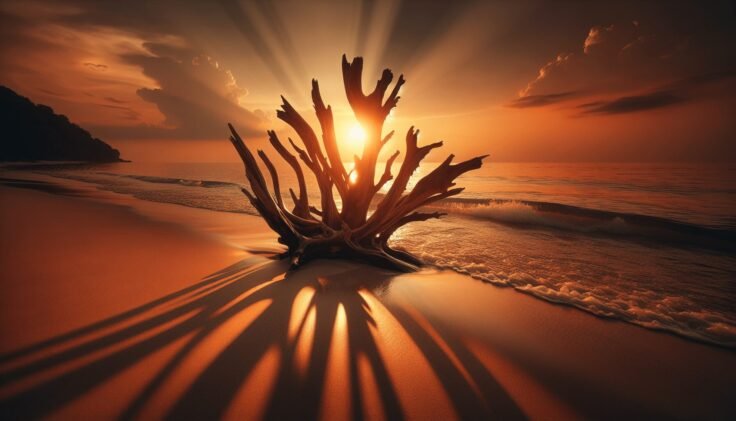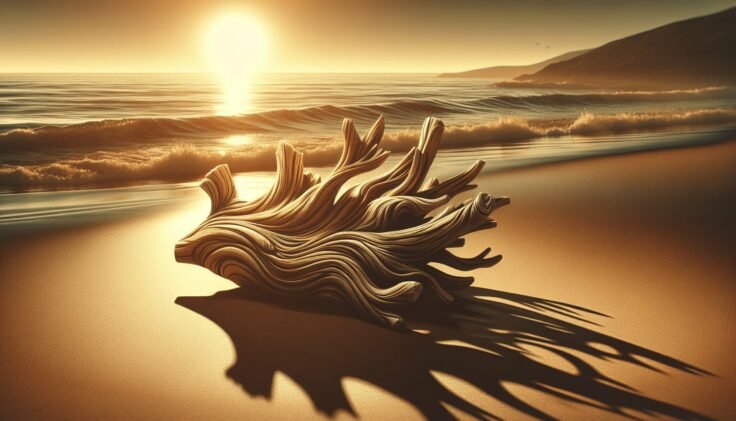Have you ever stumbled upon a piece of driftwood while walking along the beach and wondered about its journey? Driftwood, like amber, carries stories of time and transformation, elements shaped by nature’s whimsical hand. The term “Amber Driftwood” not only conjures images of beautifully aged wood washed ashore but also hints at a captivating essence intertwined with the natural history of both amber and driftwood. Understanding their nuances and connections can open a world of fascination and appreciation for these remarkable materials.

Understanding Driftwood
What is Driftwood?
Driftwood includes any wood that has found its way into rivers, seas, or oceans due to natural processes. Over time, it travels vast distances, subjected to the forces of water and weather, before eventually making its way back to shores, transformed. This type of wood can originate from many sources, including forest debris transported by river systems or logs lost during transportation. As it moves, driftwood becomes a unique piece, marked by its journey and the elements it encounters.
Driftwood Transformation
As driftwood journeys through waterways, it undergoes a transformation. This metamorphosis is largely due to saturation, the impact of waves, and interaction with other elements. Saltwater plays a significant role in stripping away the wood’s bark, altering its surface, and sometimes even changing its color. This process not only shapes the wood physically but can also imbue it with properties like buoyancy and resilience. What results is a piece of wood that tells a story of endurance and travel.
The Ecological Role of Driftwood
Beyond just being a beautiful natural artifact, driftwood serves essential ecological functions. In marine environments, it provides shelter for fish and birds and acts as a substrate for various marine life. On beaches and riverbanks, it helps reduce erosion by breaking waves and stabilizing sand and soil structures. These functions underscore the ecological importance of driftwood, highlighting its role in maintaining healthy ecosystems.
The Enchanting World of Amber
What is Amber?
Amber is fossilized tree resin, primarily derived from extinct coniferous trees. It is usually found in geological deposits, having formed over millions of years. Unlike minerals that crystallize over time, amber retains its organic nature and presents an array of colors, from pale yellows to rich golden browns and even blues or greens. These variations are influenced by the conditions under which the resin fossilized and plant species it originated from.
Formation of Amber
The journey of amber begins when trees secrete resin as a defense mechanism against pests and diseases. Over time, this resin, buried under layers of sediment, undergoes polymerization and hardens. Pressure and heat contribute to this process, transforming the resin into a stable and durable material known as amber. The mesmerization with amber often stems from its beauty and the ancient life forms it sometimes encapsulates, perfectly preserved for millennia.
Uses and Cultural Significance
Historically, amber has held immense cultural and economic significance. It was traded extensively across ancient civilizations and revered for its alleged healing properties and mystical qualities. Today, amber is prized in jewelry making, with artisans working to craft stunning pieces that capitalize on its warm hues and natural inclusions.
The Intersection: Amber Driftwood
What is Amber Driftwood?
Amber Driftwood brings together the narratives of two intriguing natural elements. It’s not just a mere blend of colors and textures—it is a concept representing the aesthetic and transformative journey shared by driftwood and amber. This term can describe pieces of driftwood with warm amber-like tones, or driftwood polished to an amber-like finish, offering a visual allure reminiscent of both materials.
Characteristics of Amber Driftwood
Amber Driftwood boasts unique characteristics, including its diverse array of colors and surface textures. The tones can range from light honey to deep amber, with the wood’s grain patterns adding depth and character. This mimicry of amber is achieved through the natural aging process, exposure to sunlight, and the effect of water, culminating in a piece that mirrors the brilliance and warmth of fossilized resin.
Artistic and Craft Applications
Artists and craftspeople find inspiration in Amber Driftwood, integrating it into various forms of creative expression. Its natural beauty makes it an appealing resource for sculptures, furniture, and home decor items that capture the imagination. Using this material, artisans can create items that resonate with the themes of nature, transformation, and time.
How to Find and Identify Amber Driftwood
Searching for Amber Driftwood
Finding Amber Driftwood is an adventure in itself, requiring a keen eye and a touch of luck. Coastal areas, riverbanks, lakesides, and estuaries are prime locations. The best times to search are after storms or high tides when new pieces are washed ashore. Patience and persistence are key as you gingerly sift through piles of debris or follow the receding tide line.
Identifying Amber Driftwood
Identifying Amber Driftwood relies on recognizing its color and texture. Look for pieces with rich golden or ruddy hues and smooth, weathered surfaces. The interaction between light and texture is a defining feature, with some pieces displaying translucent qualities under sunlight. Uncovering a piece that embodies these traits can be immensely rewarding, offering a glimpse into its long journey.

Caring for Amber Driftwood
Cleaning Techniques
Once you bring Amber Driftwood home, it’s important to clean and preserve it properly. Start by rinsing the wood under fresh water to remove salt, sand, or small marine organisms. Avoid using harsh chemicals that could damage its natural surface. For tougher stains, a gentle scrubbing with a soft brush may be necessary.
Preservation Methods
To maintain its beauty, consider applying a protective layer such as natural oil or wood conditioner. This not only enhances the wood’s luster but also protects it from cracking or fading. However, keeping in mind that some prefer to leave it untreated, appreciating how it ages naturally over time.
The Significance of Amber Driftwood in Home Decor
Integrating Amber Driftwood Into Design
Amber Driftwood offers a unique aesthetic opportunity for interior design. Its natural hues and textures can harmonize with various decor styles, from rustic and coastal to modern and minimalist. Consider using it as a statement piece in living areas or creating small accent pieces that subtly bring an element of nature indoors.
Popular Decorative Uses
Common decorative applications include driftwood wall art, centerpieces, and lighting fixtures. Its organic beauty brings warmth and character to spaces, making it a popular choice among designers and homeowners. Each piece tells its own history, adding authenticity and a touch of the natural world to your environment.
The Eco-Friendly Appeal of Amber Driftwood
Sustainable Sourcing
Using driftwood emphasizes sustainable practices, as it harnesses a naturally occurring material rather than depleting forests. By incorporating driftwood into our lives, you participate in an eco-friendly movement, celebrating the natural cycle of renewal and decay while minimizing your environmental footprint.
Supporting Local Artisans
Buying driftwood products supports local artisans who source this material responsibly and work hard to reveal its hidden beauty. These artists not only craft stunning pieces but also contribute to sustainable economies and community livelihoods through their work.
Conclusion
The poetic connection between driftwood and amber invites you to ponder their shared stories of transformation and endurance. Whether you find joy in discovering Amber Driftwood, appreciate its artistic potential, or enjoy its aesthetic appeal in your home, you join a tradition of honoring nature’s remarkable cycles. As you connect with these timeless materials, you discover the beauty in their imperfection and the history hidden within their layers. Amber Driftwood stands as a testament to nature’s ability to create beauty from change, a reminder that each piece of wood or resin holds within it a journey worth exploring.